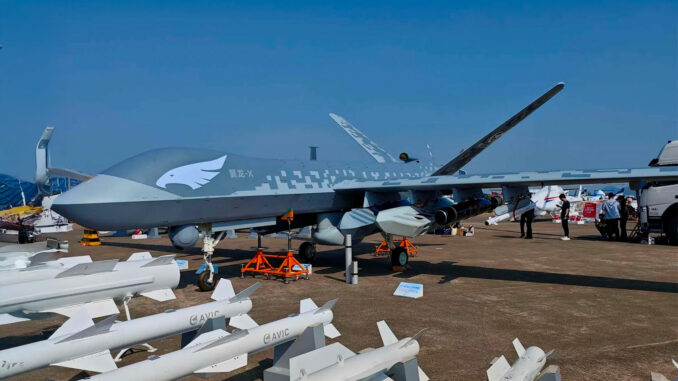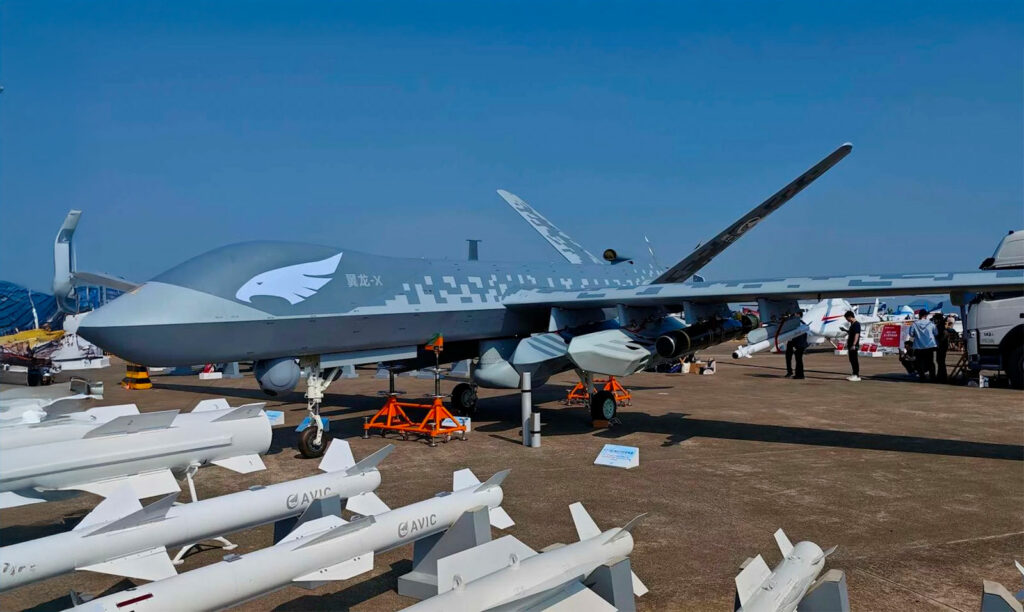
AVIC unveils the Wing Loong X in Dubai, claimed to be the world’s first anti-submarine drone, with 40 hours of endurance and AI algorithms to track submarines.
Summary
At the 2025 Dubai Airshow, Chinese manufacturer AVIC presented the Wing Loong X drone, a MALE (Medium Altitude Long Endurance) aircraft capable, according to Beijing, of detecting, tracking, and engaging submarines autonomously. With a 40-hour endurance, an announced ceiling of 10,000 meters (32,808 feet), and a wingspan exceeding 20 meters (66 feet), this anti-submarine drone is positioned as an alternative to conventional maritime patrol aircraft, which are more expensive and have more limited flight times. Configured to drop acoustic buoys, analyze signals via on-board artificial intelligence, and, if necessary, launch light torpedoes, the Wing Loong X aims to transform ASW (anti-submarine warfare) into a high-altitude, long-duration mission. Behind this technological demonstration lies a clear objective: to provide China with a tool for persistent maritime surveillance in contested areas such as the South China Sea, while expanding its export offering of combat drones. One major unknown remains: the actual performance of this autonomous anti-submarine warfare in a complex acoustic environment and against stealth submarines.
Presentation of the Wing Loong X at the 2025 Dubai Airshow
At the Dubai Airshow 2025, AVIC exhibited a full-scale model of the Wing Loong X for the first time outside China, emphasizing its ability to conduct complete anti-submarine warfare missions without a crew on board.
According to information published in the trade press, the Wing Loong X drone is presented as:
- the “world’s first unmanned aircraft” capable of autonomously detecting, tracking, and engaging submarines;
- a large UCAV (Unmanned Combat Aerial Vehicle) with a wingspan of over 20 meters (more than 65.6 feet);
- a MALE drone designed to fly up to 10,000 meters, with an endurance of up to 40 hours.
The aircraft is not entirely new: it had already been shown in Zhuhai at Airshow China 2024, where AVIC highlighted its anti-surface and anti-submarine capabilities. What is new in Dubai is the narrative: China now has an explicit ambition to engage in autonomous anti-submarine warfare, directly targeting the market of navies seeking less expensive alternatives to P-8 Poseidon-type patrol aircraft.
The design of a long-endurance anti-submarine warfare drone
A heavy MALE drone designed for the sea
The Wing Loong X is a continuation of the Wing Loong family, but on a larger scale. Described as China’s largest reconnaissance and strike drone, it has a classic MALE configuration: slender fuselage, large straight wings, V- or T-shaped tail, and turbojet or turboprop propulsion depending on the variant.
Its key features:
- wingspan: > 20 meters (≈ 66 feet);
- operational ceiling: 10,000 meters (32,808 feet);
- endurance: up to 40 hours in patrol configuration;
- large payload capacity for sensors, buoys, and weapons.
This endurance is significant: some articles point out that it far exceeds that of a Boeing P-8A Poseidon maritime patrol aircraft, which has an operational range of approximately 10 hours.
A sensor architecture dedicated to hunting submarines
The core of the anti-submarine capability of a drone such as the Wing Loong X lies in its sensor-effect suite:
- acoustic sonobuoy (sonar buoy) release pods;
- synthetic aperture maritime surveillance radar for surface detection;
- electro-optical/infrared sensors for visual identification;
- data links for cooperation with ships, aircraft, and other drones.
Sonobuoys are buoys thrown into the sea that carry one or more hydrophones. They listen to the underwater environment and send acoustic signals back to the air platform via radio link. It is this sonar-radio-analysis chain that is being transferred from the world of manned aircraft (P-3, P-8, Atlantic, etc.) to an anti-submarine warfare drone.
How autonomous submarine hunting works
An automated “detection-analysis-engagement” loop
The promise of the Wing Loong X is to move from partial support to autonomous anti-submarine warfare, where the aircraft would take on a significant part of the operational loop:
- Patrol at high altitude over an area of interest (enclosed sea, bottleneck, strategic route).
- Drop passive or active sonobuoys, depending on the mission profile, forming an acoustic field.
- Receiving acoustic data via UHF/VHF or satellite links.
- Processing by onboard AI: noise filtering, anomaly detection, classification of possible submarine signatures.
- Target tracking: merging data from several buoys, possibly from several drones, to refine the location.
- Decision to engage: either transmission of the track to naval assets, or direct attack using weapons.
AVIC claims that the Wing Loong X can not only detect, but also “coordinate attacks” with naval or air platforms, and even launch light torpedoes or suitable ammunition itself.
Weapons integration: torpedoes, missiles, and guided munitions
The models on display and official descriptions refer to a modular payload:
- light anti-submarine torpedoes (probably 200 to 300 kg);
- small-caliber anti-ship missiles;
- guided bombs for surface targets;
- possibly air-to-air missiles for self-protection or local defense.
This modularity places the Wing Loong X in the “multi-mission” category: surveillance, Chinese anti-submarine drone, surface warfare, and even contribution to local air defense.
The “swarm” dimension and cooperation between drones
AVIC also highlights the Wing Loong X’s ability to operate in a network, or even in a swarm, with other drones and platforms. Articles mention the pooling of sonar and radar data between several aircraft in order to cover large maritime areas and reduce blind spots.
This approach is part of a major trend: multiplying relatively inexpensive platforms to saturate the theater, rather than relying on a small number of large manned aircraft.
The announced performance and its likely limitations
Impressive figures on paper
The performance highlighted by Chinese communications is impressive:
- 40-hour endurance, four times that of a typical P-8;
- 10,000-meter ceiling, allowing for wide radar coverage;
- wingspan of over 20 meters, providing lift and space for sensors;
- theoretical capacity to combine several types of sensors (sonar, radar, EO/IR) and weapons.
For navies with limited budgets, a MALE drone with 40 hours of endurance capable of monitoring a strait or EEZ for several days at a time is a strong selling point.
The constraints of underwater acoustics and operational reality
In reality, autonomous anti-submarine warfare is one of the most complex missions there is:
- the acoustic environment is noisy, variable, and highly dependent on temperature, salinity, and bathymetry;
- Discrimination between a stealth submarine, a civilian vessel, a school of fish, or a natural phenomenon requires robust algorithms and very rich signature databases.
- The risk of false alarms, or conversely, non-detection, remains high.
The most advanced Western systems still rely heavily on human expertise (sonar operators, ASM analysts). The idea that a single drone could completely replace this expertise today should therefore be viewed with caution. AVIC’s announcements may be as much a matter of ambition as of fully demonstrated capability.
Vulnerability, electronic warfare, and weather
A large drone flying at 10,000 meters remains exposed to:
- long-range air-to-air or surface-to-air missiles;
- jamming and cyberattacks targeting its data links;
- adverse weather conditions at sea (strong winds, cloud cover, icing).
In the event of a high-intensity conflict, the Wing Loong X’s survival will depend on its integration into an air defense bubble and its ability to remain outside the most contested areas while maintaining its operational relevance.

Strategic implications for naval warfare
A tool for persistent maritime surveillance in contested areas
For China, the Wing Loong X drone is primarily a tool for persistent maritime surveillance in sensitive areas: the South China Sea, the Taiwan Strait, the East China Sea, and even beyond in the Western Pacific.
By combining several drones, each capable of covering hundreds of square kilometers for nearly two days, Beijing can:
- more closely track enemy submarine patrols;
- monitor approaches to its bases and sea lanes;
- respond more quickly to incursions perceived as hostile.
Additional pressure on enemy submarines
If the Wing Loong X lives up to its promises, it will complement conventional ASW capabilities (frigates, patrol aircraft, helicopters). Submarines operating near disputed waters could find themselves more frequently under the combined threat of buoys, multi-platform sensors, and armed drones.
This increased pressure may:
- complicate the freedom of action of enemy submarines in the seas near China;
- force opposing navies to invest more in acoustic stealth, diving depth, and countermeasures.
A signal to export markets and regional powers
Finally, the launch of the Wing Loong X also has a commercial dimension: China is positioning itself as a supplier of anti-submarine drones for emerging navies that lack the means or expertise to operate P-8s or full ASM fleets.
In a context where control of the seabed is becoming a major issue (cables, resources, deterrence), offering a “ready-to-use ASM” in the form of a drone potentially appeals to several customers in Asia, the Middle East, and Africa.
The Wing Loong X marks an important milestone: the shift from anti-submarine warfare to the world of long-endurance drones. China is no longer content to export ground-attack UCAVs; it is now investing in the highly technological segment of submarine hunting. It remains to be seen whether the operational reality will live up to the promises made in Dubai. Between a real breakthrough in capabilities and a high-tech showcase, this Chinese anti-submarine drone could above all accelerate a race for innovation in which submarines and drones will compete, in the silence of the depths and the skies above, for control of the seas of tomorrow.
Sources
– Army Recognition, article on the presentation of the Wing Loong X at the 2025 Dubai Airshow and its anti-submarine capabilities.
– DefenseMirror, “China Presents 40-hour Endurance Anti-submarine Drone at Dubai Airshow.”
– Global Times and Janes, analyses of the Wing Loong X at Airshow China 2024 and its ASW/ASuW capabilities.
– Interesting Engineering, NextGenDefense, The Defense Post, articles on the Wing Loong X’s onboard AI, sonobuoys, and 40-hour endurance.
– Military Watch Magazine and Vietbao, summaries on the drone’s strategic positioning and comparison with conventional maritime patrol aircraft.
War Wings Daily is an independant magazine.